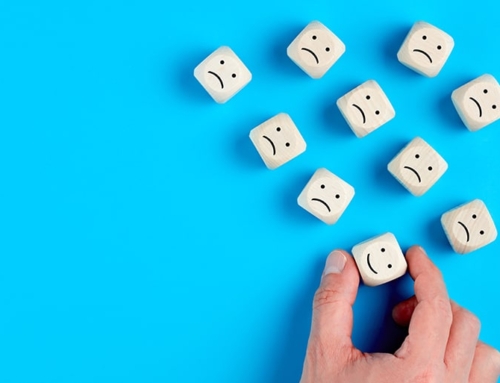Mood is central to our way of engaging with the world and with ourselves. Often in psychiatry we think of mood as an aspect of and existing within a person and when mood is disturbed, as in depression or anxiety disorders, the disturbance is internal to the self and, by extension, so must be the solutions.
We can, if we choose, expand this view in two ways. First, we can think of mood as the self’s particular way of being in the world, including how it perceives, navigates, interrogates, makes use of, and otherwise engages with the world. Mood can thus be fruitfully understood not as existing within a person but rather within the complex of self-in-world. There is no self that is not always already ensconced in the world. Thus, mood can be seen as forming the nature or style of this self-in-world complex and directing how we experience and engage within it.
The second way we can expand the understanding of mood is by considering the bidirectionality of the relationship of self and world. In this view, mood incorporates both how the self shows up in the world and how the world presents itself to the self. This second way of thinking about mood may be a bridge too far for some to cross. It suggests an agency to the world not formed or controlled by the self. The world somehow chooses to highlight certain aspects of itself to the self. This understanding, even if metaphorical, is captured in our language as, for example, when we say that something “caught my eye” or “spoke to me.” We also say that something “loomed” before us or it “gleamed” with an inner light.
The opportunity and challenge in these expanded views is that, first, the world is inexhaustible, with the potential to present an infinite number of aspects of itself to us and to other sentient creatures. And, second, we as sentient creatures have a finite but still large number of ways of showing up and interacting with the world. It was to constrain this range of possible interactions between self and world and to direct them towards goals that we have evolved to be in moods. Before we had language and rational thought, we had reflexes, drives, emotions, and moods; and they got us this far. Moods differ over time, shifting quickly or persisting for months or years, but we can never not be in a mood. Sometimes the mood is neutral and benign and disappears into the background, but, even then, a mood is present, and it constrains and directs the self’s being in the world. It is the mood that sets the parameters, that adds emotional coloring to, and that attunes us and the world to a much narrower range of interactions. When in a mood, only certain ways of perceiving, thinking about, and acting in the world arise. And with respect to the bidirectional relationship, when in a mood, the world will present only certain aspects of itself to us.
One implication for me of this expanded way of understanding mood is that when mood is disturbed, it is the complex of self-in-world that should be addressed, including the self, the world, and the fit between them. The self, isolated from the world, should not be made the sole culprit of the disturbance and the sole focus of intervention. The dynamic complex of self-in-world can be given its due, evaluated, and addressed as a whole.
A person seeking treatment may appreciate taking this broader view. The message is not “It is you who are broken” and instead is “The interactions between you and the world are hurtful to you and constrain your ability to live fully, with vitality and purpose and mastery, with appreciation from the world, and, in turn, with your ability to offer your value to the world.” This leads naturally to statements like, “Let’s work together to make the fit between you and your world a more comfortable, affirming, and meaningful one. And let’s brainstorm on what this will look like, what you might want to change in yourself, what might need to change in your world, and how I may be able to help.”
“In the midst of winter, I found there was, within me, an invincible summer.” ― Albert Camus
“The sun shone, having no alternative, on the nothing new.” ― Samuel Beckett
The most common result of this type of investigation is that both the person and their world require, or at least would benefit from, undergoing change. Change in self will lead to change in the world and vice versa. Whatever changes occur affect the entire complex. So, when we engage a patient in cognitive restructuring, that is sometimes enough: this limited change changes the entire complex of self-in-world. But, we all know, many times cognitive restructuring as well as other psychotherapies, medications, and all these interventions together, do not work. This leaves us clinicians and our patients with trying to figure which intervention or set of interventions to start with. This is both a challenge and an opportunity, one that permits considering a much broader range of possible changes. Sometimes, it is best to turn the focus away from the patient and instead focus on changing the context and conditions in which they move through the world. This is what we do with and for children. We raise them; we set the conditions in which they can thrive. We inculcate them with values and habits. We expect that the nature of the conditions in which they live will shape them, will affect what they will tend to do and not do.
On the other hand, despite opening us to a wider range of possible interventions, this complex of self-in-world also carries a certain ballast and tends to resist change and, when moved away from its habitual interactions, to self-correct into its prior state, even if that prior state resulted in dysfunction and suffering. So, not every patient needs a full court press, but many patients do. Many patients will benefit from the simultaneous application of several interventions simultaneously, some focused directly on evaluating and changing their thoughts, emotions, and behaviors, and others focused on changing the conditions in which they live. Being mindful of the self-in-world complex gives me confidence in the range of possible changes the patient and I can work to try to bring about. With this perspective I never ever run out of options, and I never overly focus on one type of intervention to the detriment of the others. In fact, I often have faced the opposite problem: there are too many promising interventions crying out to be implemented, that the challenge is in prioritizing them, choosing some for now and delaying others. So, implementing more than one intervention at a time often is beneficial, but there are limits. Trying to do too many things at once can overwhelm the patient, leading to worse adherence and lower trust in the therapeutic relationship and in me.
What I refer to here may sound like nothing more than our tried-and-true biopsychosocial approach to evaluation and intervention. Although quite helpful, the biopsychosocial approach has the shortcoming that each part, the bio, psycho, and social, can seem unintegrated and often superfluous. If reconsidered as the self-in-world, then the bio, psycho, and social interventions become highly integrated. The main focus is on the fit between self and world and only secondarily on the self and the world in isolation.
To conclude this section. I realize, of course, that not every patient may be in a position to hear the questions I proposed above and to respond to them with positive regard. A person may be too beat down, have suffered too much abuse and trauma, and have their resources too depleted. The initial goal may need to be to stabilize, to shore up, and only those initial goals are achieved, to consider more broadly how to reconfigure one’s being in the world.
Until next time,
Dr. Jack
Language Brief
“Live to the point of tears.” ― Albert Camus
“If I take death into my life, acknowledge it, and face it squarely, I will free myself from the anxiety of death and the pettiness of life – and only then will I be free to become myself.” ― Martin Heidegger
“I was going to die, sooner or later, whether or not I had even spoken myself. My silences had not protected me. Your silences will not protect you. What are the words you do not yet have? What are the tyrannies you swallow day by day and attempt to make your own, until you will sicken and die of them, still in silence?” ― Audre Lorde







Leave A Comment